Abstract
Purpose
To report the clinical characteristics and prevalence of Charles Bonnet syndrome (CBS) in patients with retinal diseases in the Republic of Korea.
Methods
Patients with deterioration of visual acuity or visual field or episodes of complex visual hallucination (cVH) with retinal diseases between March 2019 and June 2019 at the retinal outpatient clinic of the Chonbuk National University Hospital were selected to answer standardized questions to determine whether they had symptoms of CBS.
Results
The selected 303 patients from the total of 2,916 patients were comprised of 163 males (53.8%) and 140 females (46.2%). The mean age of the patients was 66.0 ± 15.1 years. six patients (2.4%) of 245 with no response to initial question in 301 with best-corrected visual acuity less than finger counting and two patients with experience of cVH were diagnosed with CBS. Most patients had seen a wide variety of hallucinations, including objects, people, and scenery, with negative emotions, for > 1 year. The hallucinations were experienced daily with the same frequency. Negative feelings such as fear and worry improved when they received appropriate patient education about the hallucinations.
Conclusions
The prevalence of CBS in the Republic of Korea is higher than previously reported. We found that relatively young patients with visual impairment could experience cVH from CBS. CBS patients experienced negative emotions for long periods due to the hallucinations which decreased their quality of life. CBS should be considered during the differential diagnosis of cVH in patients with visual impairment due to ophthalmic diseases. We should also provide appropriate patient education to assist them in understanding more fully the clinical characteristics of CBS.
Figures and Tables
 | Figure 1Characteristics of selected group (n = 303) to ask standardized questions. (A) Age and gender distribution. (B) Ophthalmic diagnoses. MH = macular hole; ERM = epiretinal membrane; RAO = retinal artery occlusion; ME = macular edema; CD = choroidal detachment; PVR = proliferative vitreoretinopathy; ON = optic neuropathy. |
Table 2
Characteristics of patients of Charles Bonnet syndrome

R = right; NLP = no light perception; L = left; FC = finger counting; HM = macular hole; B = both; RP = retinitis pigmentosa; NPDR = non proliferative diabetic retinopathy; ERM = epiretinal membrane; ARMD = age-related macular degeneration; CRVO = central retinal vein occlusion; PXG = pseudoexfoliation glaucoma; N/S = non-specific.
*Visual acuity on the most recent visit.
References
1. Tan CS, Lim VS, Ho DY, et al. Charles Bonnet syndrome in Asian patients in a tertiary ophthalmic centre. Br J Ophthalmol. 2004; 88:1325–1329.
2. Podoll K, Osterheider M, Noth J. The Charles Bonnet syndrome. Fortschr Neurol Psychiatr. 1989; 57:43–60.
3. Teunisse RJ, Cruysberg JR, Hoefnagels WH, et al. Social and psychological characteristics of elderly visually handicapped patients with the Charles Bonnet Syndrome. Compr Psychiatry. 1999; 40:315–319.
4. Abbott EJ, Connor GB, Artes PH, Abadi RV. Visual loss and visual hallucinations in patients with age-related macular degeneration (Charles Bonnet syndrome). Invest Ophthalmol Vis Sci. 2007; 48:1416–1423.
5. Tan CS, Au Eong KG. Charles Bonnet syndrome: hallucinations may not be what they seem. Clin Exp Optom. 2004; 87:405–406.
6. Rovner BW. The Charles Bonnet syndrome: a review of recent research. Curr Opin Ophthalmol. 2006; 17:275–277.
7. Fernandez A, Lichtshein G, Vieweg WV. The Charles Bonnet syndrome: a review. J Nerv Ment Dis. 1997; 185:195–200.
8. Santos-Bueso E, Serrador-García M, Porta-Etessam J, et al. Charles Bonnet syndrome. A 45-case series. Rev Neurol. 2015; 60:337–340.
9. Santos-Bueso E, Porta-Etessam J, Sáenz-Francés F, et al. Charles Bonnet syndrome and the association with dementia. Arch Soc Esp Oftalmol. 2014; 89:43–44.
10. Pliskin NH, Kiolbasa TA, Towle VL, et al. Charles Bonnet syndrome: an early marker for dementia? J Am Geriatr Soc. 1996; 44:1055–1061.
11. Barodawala S, Mulley GP. Visual hallucinations. J R Coll Physicians Lond. 1997; 31:42–48.
12. Manford M, Andermann F. Complex visual hallucinations. Clinical and neurobiological insights. Brain. 1998; 121(Pt 10):1819–1840.
13. Diederich N, Pieri V, Goetz C. Visual hallucinations in Parkinson and Charles Bonnet Syndrome patients. A phenomenological and pathogenetic comparison. Fortschr Neurol Psychiatr. 2000; 68:129–136.
14. Matsui H, Udaka F, Oda M, et al. Two cases of Parkinson’s disease in which hallucinations disappeared after cataract surgery. No To Shinkei. 2004; 56:351–354.
15. Lerario A, Ciammola A, Poletti B, et al. Charles Bonnet syndrome: two case reports and review of the literature. J Neurol. 2013; 260:1180–1186.
16. Santos-Bueso E, Porta-Etessam J. Charles Bonnet syndrome. Diagnostic criteria. Arch Soc Esp Oftalmol. 2016; 91:511–512.
17. Nalcaci S, İlim O, Oztas Z, et al. The prevalence and characteristics of Charles Bonnet Syndrome in Turkish patients with retinal disease. Ophthalmologica. 2016; 236:48–52.
18. Schadlu AP, Schadlu R, Shepherd JB 3rd. Charles Bonnet syndrome: a review. Curr Opin Ophthalmol. 2009; 20:219–222.
19. Vukicevic M, Fitzmaurice K. Butterflies and black lacy patterns: the prevalence and characteristics of Charles Bonnet hallucinations in an Australian population. Clin Exp Ophthalmol. 2008; 36:659–665.
20. Cox TM, ffytche DH. Negative outcome Charles Bonnet syndrome. Br J Ophthalmol. 2014; 98:1236–1239.
21. Badcock JC, Dehon H, Larøi F. Hallucinations in healthy older adults: an overview of the literature and perspectives for future research. Front Psychol. 2017; 8:1134.
22. Yoon HN. Necessity and methods of sexual education in the elderly population. J Korean Med Assoc. 2019; 62:320–324.
23. Choi EJ, Lee JK, Kang JK, Lee SA. Complex visual hallucinations after occipital cortical resection in a patient with epilepsy due to cortical dysplasia. Arch Neurol. 2005; 62:481–484.
24. Lee JS, Kim SY. A case of Charles Bonnet Syndrome following cerebral infarction in the right occipital lobe. J Korean Neurol Assoc. 2006; 24:577–580.
25. Han SB, Hwang JM. A case of Charles Bonnet Syndrome After resection of a meningioma. J Korean Ophthalmol Soc. 2008; 49:539–542.
26. Byun YS, Shin SJ, Yang SW. A case of Charles Bonnet Syndrome after enucleation. J Korean Ophthalmol Soc. 2008; 49:669–672.
27. Holroyd S, Rabins PV, Finkelstein D, et al. Visual hallucinations in patients with macular degeneration. Am J Psychiatry. 1992; 149:1701–1706.
28. Gordon KD. Prevalence of visual hallucinations in a national low vision client population. Can J Ophthalmol. 2016; 51:3–6.
29. Scott IU, Schein OD, Feuer WJ, Folstein MF. Visual hallucinations in patients with retinal disease. Am J Ophthalmol. 2001; 131:590–598.
30. Damas-Mora J, Skelton-Robinson M, Jenner FA. The Charles Bonnet syndrome in perspective. Psychol Med. 1982; 12:251–261.
31. Schultz G, Melzack R. The Charles Bonnet syndrome: 'phantom visual images'. Perception. 1991; 20:809–825.
32. Plummer C, Kleinitz A, Vroomen P, Watts R. Of Roman chariots and goats in overcoats: the syndrome of Charles Bonnet. J Clin Neurosci. 2007; 14:709–714.
33. Burke W. The neural basis of Charles Bonnet hallucinations: a hypothesis. J Neurol Neurosurg Psychiatry. 2002; 73:535–541.
34. Teunisse RJ, Cruysberg JR, Verbeek A, Zitman FG. The Charles Bonnet syndrome: a large prospective study in The Netherlands. A study of the prevalence of the Charles Bonnet syndrome and associated factors in 500 patients attending the University Department of Ophthalmology at Nijmegen. Br J Psychiatry. 1995; 166:254–257.
35. Menon GJ, Rahman I, Menon SJ, Dutton GN. Complex visual hallucinations in the visually impaired: the Charles Bonnet Syndrome. Surv Ophthalmol. 2003; 48:58–72.
36. Teunisse RJ, Cruysberg JR, Hoefnagels WH, et al. Visual hallucinations in psychologically normal people: Charles Bonnet's syndrome. Lancet. 1996; 347:794–797.
37. Teunisse RJ, Cruysberg JR, Hoefnagels WH, et al. Risk indicators for the Charles Bonnet syndrome. J Nerv Ment Dis. 1998; 186:190–192.
38. Lepore FE. Spontaneous visual phenomena with visual loss: 104 patients with lesions of retinal and neural afferent pathways. Neurology. 1990; 40(3 Pt 1):444–447.
39. Tan CS, Sabel BA, Goh KY. Visual hallucinations during visual recovery after central retinal artery occlusion. Arch Neurol. 2006; 63:598–600.
40. Madill SA, Ffytche DH. Charles Bonnet syndrome in patients with glaucoma and good acuity. Br J Ophthalmol. 2005; 89:785–786.
41. Toosy AT, Roberton BJ, Jayaram H, Plant GT. Monocular complex visual hallucinations and their suppression by eye closure. Eye (Lond). 2006; 20:732–733.
42. Shiraishi Y, Terao T, Ibi K, et al. The rarity of Charles Bonnet syndrome. J Psychiatr Res. 2004; 38:207–213.
43. Hou Y, Zhang Y. The prevalence and clinical characteristics of Charles Bonnet syndrome in Chinese patients. Gen Hosp Psychiatry. 2012; 34:566–570.
44. Singh A, Sørensen TL. The prevalence and clinical characteristics of Charles Bonnet Syndrome in Danish patients with neovascular age-related macular degeneration. Acta Ophthalmol. 2012; 90:476–480.
45. Levine AM. Visual hallucinations and cataracts. Ophthalmic Surg. 1980; 11:95–98.
46. Holroyd S, Rabins PV. A three-year follow-up study of visual hallucinations in patients with macular degeneration. J Nerv Ment Dis. 1996; 184:188–189.
47. Lautenschlager NT, Almeida OP. Physical activity and cognition in old age. Curr Opin Psychiatry. 2006; 19:190–193.
48. Kim YJ, Han JW, So YS, et al. Prevalence and trends of dementia in Korea: a systematic review and meta-analysis. J Korean Med Sci. 2014; 29:903–912.




 PDF
PDF ePub
ePub Citation
Citation Print
Print




 XML Download
XML Download